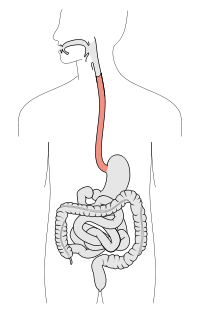
Photo from wikipedia
Simple Summary Clinicopathological features and immunohistochemical subtype were evaluated in patients with remnant gastric cancer considering the initial cause of partial gastrectomy. In the malignant group, the proportion of male… Click to show full abstract
Simple Summary Clinicopathological features and immunohistochemical subtype were evaluated in patients with remnant gastric cancer considering the initial cause of partial gastrectomy. In the malignant group, the proportion of male patients was substantially lower, with a shorter interval between initial partial gastrectomy and remnant gastric cancer. In the background mucosa around the carcinomas, incidence of high-grade pyloric metaplasia was significantly higher in the benign group (13/20, 65.0% vs. 10/28, 35.7%), while high-grade intestinal metaplasia was only observed in the malignant group (0/20, 0% vs. 7/28, 25.0%). The pathogenesis of remnant gastric cancer may differ depending on the initial disease. Benign disease was prevalently associated with pyloric metaplasia. Malignant disease was also accompanied by intestinal metaplasia. Abstract Background: The incidence of gastric cancer increases in the remnant stomach after partial gastrectomy; however, its pathogenesis remains controversial. The clinicopathological features and immunohistochemical subtype were evaluated in patients with remnant gastric cancer considering the initial cause of partial gastrectomy. Methods: We categorized 59 cases of remnant gastric cancer who underwent curative surgery between 2001 and 2016 according to initial pathologies of benign (n = 24) or malignant (n = 35). Histological changes including pyloric metaplasia and intestinal metaplasia in the mucosa around the anastomosis site and the background mucosa of carcinomas were compared between the groups. Results: In the malignant group, the proportion of male patients was substantially lower, with a shorter interval. In background mucosa around the carcinomas, incidence of high-grade pyloric metaplasia was significantly higher in the benign group (13/20, 65.0% vs. 10/28, 35.7%), while high-grade intestinal metaplasia was only observed in the malignant group (0/20, 0% vs. 7/28, 25.0%). Conclusions: The cancers in the initial benign disease are mainly associated with pyloric metaplasia at the anastomosis site, reflecting reflux, but not with intestinal metaplasia. On the other hand, in the initial malignant disease group, intestinal metaplasia has an equally important role as reflux-associated pyloric metaplasia.
Journal Title: Cancers
Year Published: 2020
Link to full text (if available)
Share on Social Media: Sign Up to like & get
recommendations!